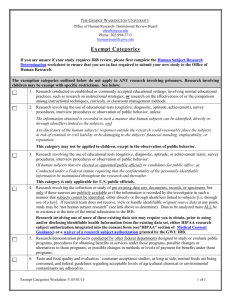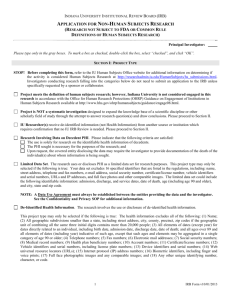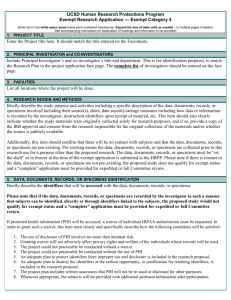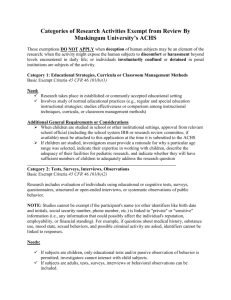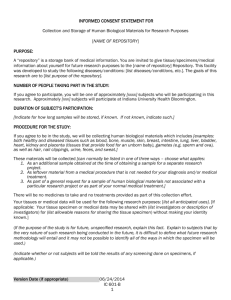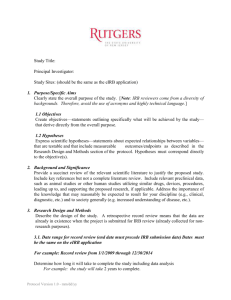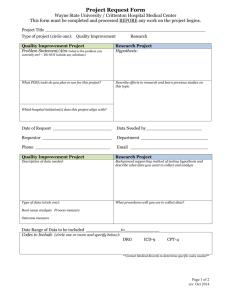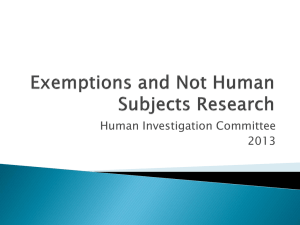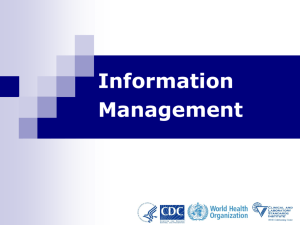IRB Research Plan Template: Secondary Data Analysis
advertisement
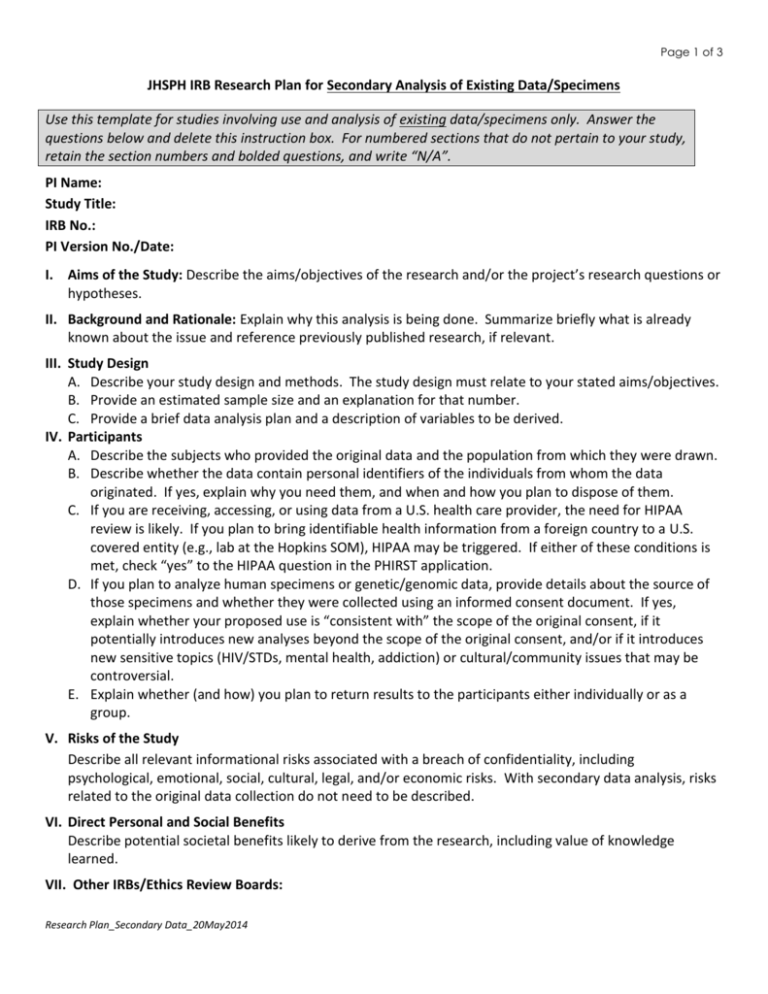
Page 1 of 3 JHSPH IRB Research Plan for Secondary Analysis of Existing Data/Specimens Use this template for studies involving use and analysis of existing data/specimens only. Answer the questions below and delete this instruction box. For numbered sections that do not pertain to your study, retain the section numbers and bolded questions, and write “N/A”. PI Name: Study Title: IRB No.: PI Version No./Date: I. Aims of the Study: Describe the aims/objectives of the research and/or the project’s research questions or hypotheses. II. Background and Rationale: Explain why this analysis is being done. Summarize briefly what is already known about the issue and reference previously published research, if relevant. III. Study Design A. Describe your study design and methods. The study design must relate to your stated aims/objectives. B. Provide an estimated sample size and an explanation for that number. C. Provide a brief data analysis plan and a description of variables to be derived. IV. Participants A. Describe the subjects who provided the original data and the population from which they were drawn. B. Describe whether the data contain personal identifiers of the individuals from whom the data originated. If yes, explain why you need them, and when and how you plan to dispose of them. C. If you are receiving, accessing, or using data from a U.S. health care provider, the need for HIPAA review is likely. If you plan to bring identifiable health information from a foreign country to a U.S. covered entity (e.g., lab at the Hopkins SOM), HIPAA may be triggered. If either of these conditions is met, check “yes” to the HIPAA question in the PHIRST application. D. If you plan to analyze human specimens or genetic/genomic data, provide details about the source of those specimens and whether they were collected using an informed consent document. If yes, explain whether your proposed use is “consistent with” the scope of the original consent, if it potentially introduces new analyses beyond the scope of the original consent, and/or if it introduces new sensitive topics (HIV/STDs, mental health, addiction) or cultural/community issues that may be controversial. E. Explain whether (and how) you plan to return results to the participants either individually or as a group. V. Risks of the Study Describe all relevant informational risks associated with a breach of confidentiality, including psychological, emotional, social, cultural, legal, and/or economic risks. With secondary data analysis, risks related to the original data collection do not need to be described. VI. Direct Personal and Social Benefits Describe potential societal benefits likely to derive from the research, including value of knowledge learned. VII. Other IRBs/Ethics Review Boards: Research Plan_Secondary Data_20May2014 Page 2 of 3 If the research will require review by other IRBs, provide the name and contact information for each IRB/ethics review board and its Federal Wide Assurance, if it has one (available on OHRP’s website at http://www.hhs.gov/ohrp/assurances). VIII. Collaborations with non-JHSPH Institutions (skip this question if your study is not funded): For funded studies that involve collaboration with non-JHSPH institutions, complete the chart below to describe the funding of the project and which organization is the primary or secondary grant recipient. This information helps us determine what IRB oversight is required for each party. Insert Name of Institutions in Partner column(s); add additional columns if necessary. JHSPH Partner 1 Partner 2 Primary Grant Recipient Subcontractor IX. Data Custody, Security, and Confidentiality Protections The sections below describe types of data sources and how they will be protected. For the type(s) of data you will have, put an “X” in the appropriate box to the left of the section that best describes how you will minimize the risk of a breach of confidentiality for your study. Note, as appropriate, how you will record/store data. These descriptions represent MINIMAL measures; you may add more stringent protections and other relevant information in B. Confidentiality: The LOSS OR THEFT of 1) original/duplicate version of physical data collection instruments (forms, tapes, etc) or 2) physical devices containing electronic data (i.e. laptop/mobile device, external flash drive(s), is a threat to subject confidentiality. Risk of such a loss/theft is increased during movement/transport of data (in any format), such as in a vehicle or other move. Be sure to train anyone (co-investigators, staff, students, etc.) who might be engaged in the oversight of data handling/storage about this problem. Some typical risk-mitigation strategies would include: minimizing the physical movement of data and/or devices containing data encrypting electronic data (especially when stored on any mobile device, including flash memory tools, phones, tablets, etc, or when transferring across networks) making use of reliable courier services (FedEx, DHL, etc) when physical transport of bulk data forms is necessary minimizing the transfer of identifiable data in physical or electronic form (i.e. removing/separating/destroying identifiable data, when physical transfer of data is necessary) A. Data Storage 1. Hard Copies of Data Collection Forms. This activity will not involve receiving and/or accessing hard copies of data Data collection forms RECORD NO PERSONAL IDENTIFIERS connecting study participants, and there are no codes providing a link. Data are anonymous. Data collection forms INCLUDE IDENTIFIERS. The forms are locked in a secure cabinet or room with limited access by authorized individuals. Forms will be kept in study team’s possession during transport and will not be left unattended in a vehicle. When possible, de-identified Research Plan_Secondary Data_20May2014 Page 3 of 3 copies will be used for coding and analysis. Data collection forms ARE CODED with study participants’ random study ID numbers. Codes/links between study IDs and identifiers are stored securely in a separate place (locked storage cabinet or secure electronic database.) Other: 2. Electronic Database Used in Analysis The database does not contain personally identifiable information These data are stored on a secure server protected by limited access and strong password systems. Data are coded when possible. Portable electronic devices will not contain identifiable information unless encrypted. Other: 3. Other Identifiable Data Storage, Retention, and Destruction (Audiotapes, videotapes, photographs, etc.) will be retained and stored securely (locked in cabinet or room) until: Transcription is complete, then will be destroyed. Analysis is complete, then will be destroyed. Study is complete and file is closed. Indefinitely. Provide justification for indefinite retention: 4. Existing Biospecimens to be used in this study: HAVE NO PERSONAL IDENTIFIERS. INCLUDE IDENTIFIERS AND ARE CODED; the PI will not have access to the link or code connecting the identifiers to the specimens. INCLUDE IDENTIFIERS, and the PI has access to those identifiers or to the link/code connecting specimens to individuals. The identifiers and/or code will be stored securely until the study is complete. B. Certificate of Confidentiality Will the study data stored in the United States be protected by a Certificate of Confidentiality? If yes, explain who will apply for and maintain the Certificate. (http://grants.nih.gov/grants/policy/coc/appl_extramural.htm) C. Secondary data analysis confers the same expectations for responsible stewardship of data as does primary data collection. Describe any additional plans beyond those identified in the table that you have for storing and sharing the study data and/or materials, and how responsibility for the data will be managed. The use of clinical data from Johns Hopkins Hospital and its affiliates requires a security review by Johns Hopkins Medicine. If you seek to access a dataset of 500 clinical records or larger, complete the JHM Data Security Checklist on the IRB Website. Research Plan_Secondary Data_20May2014
